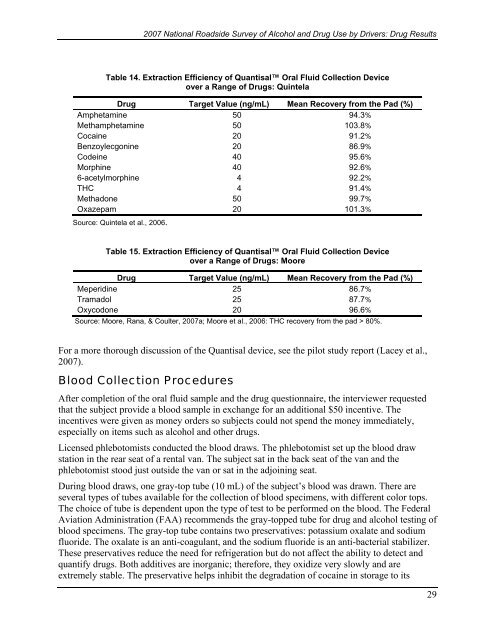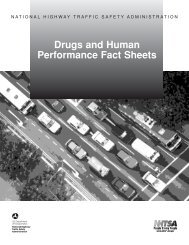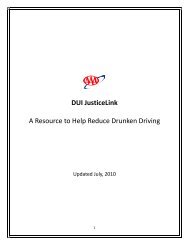2007 National Roadside Survey of Alcohol and Drug Use by Drivers
2007 National Roadside Survey of Alcohol and Drug Use by Drivers
2007 National Roadside Survey of Alcohol and Drug Use by Drivers
You also want an ePaper? Increase the reach of your titles
YUMPU automatically turns print PDFs into web optimized ePapers that Google loves.
<strong>2007</strong> <strong>National</strong> <strong>Roadside</strong> <strong>Survey</strong> <strong>of</strong> <strong>Alcohol</strong> <strong>and</strong> <strong>Drug</strong> <strong>Use</strong> <strong>by</strong> <strong>Drivers</strong>: <strong>Drug</strong> ResultsTable 14. Extraction Efficiency <strong>of</strong> Quantisal Oral Fluid Collection Deviceover a Range <strong>of</strong> <strong>Drug</strong>s: Quintela<strong>Drug</strong> Target Value (ng/mL) Mean Recovery from the Pad (%)Amphetamine 50 94.3%Methamphetamine 50 103.8%Cocaine 20 91.2%Benzoylecgonine 20 86.9%Codeine 40 95.6%Morphine 40 92.6%6-acetylmorphine 4 92.2%THC 4 91.4%Methadone 50 99.7%Oxazepam 20 101.3%Source: Quintela et al., 2006.Table 15. Extraction Efficiency <strong>of</strong> Quantisal Oral Fluid Collection Deviceover a Range <strong>of</strong> <strong>Drug</strong>s: Moore<strong>Drug</strong> Target Value (ng/mL) Mean Recovery from the Pad (%)Meperidine 25 86.7%Tramadol 25 87.7%Oxycodone 20 96.6%Source: Moore, Rana, & Coulter, <strong>2007</strong>a; Moore et al., 2006: THC recovery from the pad > 80%.For a more thorough discussion <strong>of</strong> the Quantisal device, see the pilot study report (Lacey et al.,<strong>2007</strong>).Blood Collection ProceduresAfter completion <strong>of</strong> the oral fluid sample <strong>and</strong> the drug questionnaire, the interviewer requestedthat the subject provide a blood sample in exchange for an additional $50 incentive. Theincentives were given as money orders so subjects could not spend the money immediately,especially on items such as alcohol <strong>and</strong> other drugs.Licensed phlebotomists conducted the blood draws. The phlebotomist set up the blood drawstation in the rear seat <strong>of</strong> a rental van. The subject sat in the back seat <strong>of</strong> the van <strong>and</strong> thephlebotomist stood just outside the van or sat in the adjoining seat.During blood draws, one gray-top tube (10 mL) <strong>of</strong> the subject’s blood was drawn. There areseveral types <strong>of</strong> tubes available for the collection <strong>of</strong> blood specimens, with different color tops.The choice <strong>of</strong> tube is dependent upon the type <strong>of</strong> test to be performed on the blood. The FederalAviation Administration (FAA) recommends the gray-topped tube for drug <strong>and</strong> alcohol testing <strong>of</strong>blood specimens. The gray-top tube contains two preservatives: potassium oxalate <strong>and</strong> sodiumfluoride. The oxalate is an anti-coagulant, <strong>and</strong> the sodium fluoride is an anti-bacterial stabilizer.These preservatives reduce the need for refrigeration but do not affect the ability to detect <strong>and</strong>quantify drugs. Both additives are inorganic; therefore, they oxidize very slowly <strong>and</strong> areextremely stable. The preservative helps inhibit the degradation <strong>of</strong> cocaine in storage to its29




